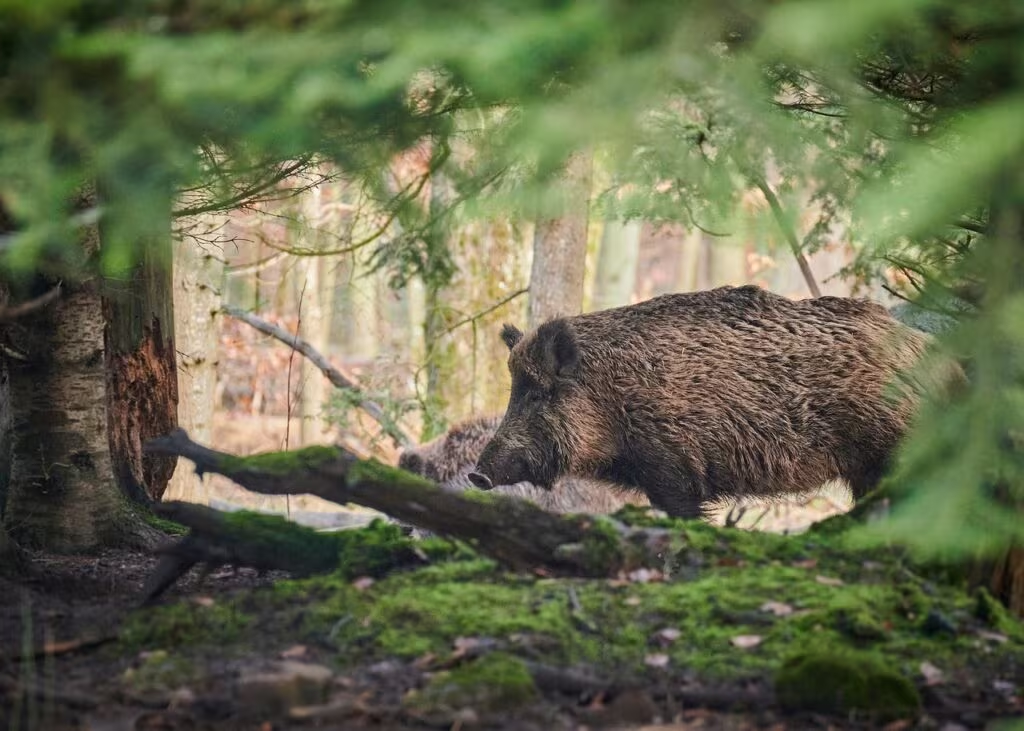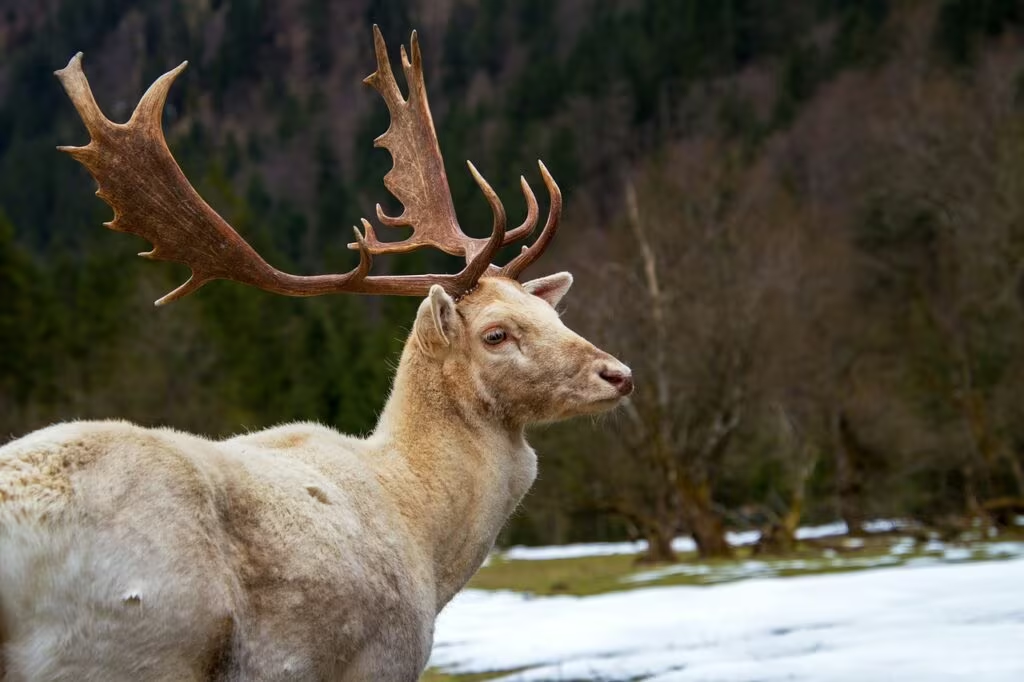Unprecedented Wildlife Encounter at Thomayer Hospital
On November 17, 2024, visitors and staff at Thomayer University Hospital in Prague, Czech Republic, were treated to an extraordinary spectacle when a high-speed chase between two large wild animals ended dramatically at the facility’s main entrance. The incident, captured on video by a hospital visitor, highlighted the increasing overlap between urban infrastructure and the natural habitats that border major European cities.
The confrontation involved a wild boar aggressively pursuing a deer across the hospital grounds. The chase culminated when the panicked deer, attempting to evade its pursuer, crashed directly into the large glass doors of the hospital building, momentarily stunning itself before both animals retreated back into the adjacent woodland.
This event, while unusual in its location, serves as a vivid reminder of the rich biodiversity present in Prague’s green spaces and the challenges faced by wildlife navigating human environments.
The Viral Footage: A Showdown on Hospital Grounds
The incident was documented by Marek Novák, a visitor to the hospital, whose footage quickly gained attention for its sheer drama and unexpected setting. The video shows the deer, moving at full speed, attempting to escape the relentless pursuit of the boar.
Upon reaching the solid glass façade of the hospital, the deer collided with the doors, creating a loud impact that momentarily halted the chase. The deer appeared disoriented and stunned for a few seconds on the pavement before regaining its footing and quickly darting away. The wild boar, which had paused during the collision, immediately resumed the chase, following the deer off the paved hospital area and back toward the forest.
Hospital officials confirmed the event, noting that while the sight of a chase is rare, the presence of these animals on the grounds is not. Fortunately, neither the animals nor any people were reported to be seriously injured during the brief but intense encounter.

The Ecology of Krč Forest: Why Wildlife Roam Urban Edges
Thomayer University Hospital is a major medical center serving approximately 50,000 people annually. Crucially, it is situated directly on the border of the Krč Forest (Krčský les), one of Prague’s largest and most important natural areas.
The forest acts as a vital ecological corridor, home to a diverse population of European wildlife. The animals involved in the chase—the European roe deer and the wild boar (Sus scrofa)—are two of the most common large mammals found in this habitat.
Understanding the Incursion
Wildlife experts suggest that such incursions into urban areas are often driven by several factors:
- Foraging: Boars, in particular, are highly adaptable omnivores constantly seeking food sources, which can include hospital waste or landscaped areas.
- Territorial Disputes: The chase may have been initiated by a territorial dispute, especially if the boar felt threatened or was defending a resource.
- Rutting Season: While the deer rutting season peaks earlier, aggressive behavior can persist, leading to high-speed chases.
- Habitat Fragmentation: As urban development encroaches on forest edges, the boundary between human and animal territory becomes increasingly blurred, leading to more frequent, and sometimes dramatic, interactions.

Expert Context: The Dynamics of Boar and Deer Interactions
While wild boars and deer coexist in the same environment, a direct, aggressive chase of this nature is noteworthy. Wild boars are generally omnivorous, feeding primarily on plants, roots, insects, and carrion. They are not typical predators of adult deer, but they can be highly aggressive, especially when defending young or prime foraging territory.
In this specific instance, the boar’s motivation was likely territorial dominance or simple aggression rather than a predatory hunt. The deer, recognizing the threat posed by the powerful and often unpredictable boar, reacted with immediate flight, which unfortunately led it directly toward the hospital structure.
The Impact of Infrastructure
The collision of the deer with the glass doors underscores a significant challenge for urban wildlife: the prevalence of reflective and transparent human structures. Animals, particularly those moving at high speeds in panic, often fail to perceive glass as a solid barrier.
“When animals are under extreme stress or moving rapidly, their focus is entirely on escape. They don’t process the visual cues of glass or reflective surfaces as solid obstacles, leading to dangerous collisions with buildings, fences, and vehicles,” explains a local wildlife conservationist.

Mitigation and Coexistence Strategies
For institutions like Thomayer Hospital, which are situated near major natural reserves, managing the interface between human activity and wildlife is an ongoing necessity. Strategies for minimizing conflict often focus on reducing attractants and clearly delineating boundaries.
Key strategies for urban-edge facilities include:
- Waste Management: Securing all external waste containers to prevent boars from accessing food scraps, which are a primary draw.
- Fencing and Barriers: Implementing low-impact fencing or natural barriers that discourage large animals from entering high-traffic areas without completely blocking ecological movement.
- Landscaping Choices: Avoiding the use of plants, bulbs, or ground cover that are particularly attractive to foraging boars.
- Public Awareness: Educating staff and visitors, like Marek Novák, on how to react safely when encountering large wildlife, emphasizing the need to give the animals space.
The incident at Thomayer Hospital serves as a compelling, albeit dramatic, case study in the complexities of urban ecology, where the needs of a major medical facility must constantly adapt to the powerful, unpredictable forces of the wild world right next door.
Key Takeaways
- The Incident: On November 17, 2024, a wild boar chased a deer onto the grounds of Thomayer University Hospital in Prague, resulting in the deer crashing into the hospital’s glass doors.
- The Location: The hospital is situated adjacent to the Krč Forest, a large natural habitat that is home to abundant wildlife, including boars and deer.
- The Witness: The event was filmed by hospital visitor Marek Novák.
- The Outcome: The deer was stunned but quickly recovered and fled back into the forest, followed by the boar. No serious injuries were reported to either animals or people.
- Ecological Context: The event underscores the challenges of urban sprawl and the need for effective strategies to manage human-wildlife interactions at the edges of natural reserves.
Conclusion and Outlook
The dramatic footage from Thomayer Hospital provides a rare glimpse into the intense natural struggles occurring just steps away from human civilization. While the event was startling, it confirms the robust health of the wildlife population in the Krč Forest and the necessity for urban planners and institutions to consider ecological factors in their design and operation. As cities continue to expand, managing these dynamic boundaries effectively will be crucial for ensuring both public safety and the continued survival of urban-adjacent wildlife.
Original author: Stephen Messenger
Originally published: November 7, 2025
Editorial note: Our team reviewed and enhanced this coverage with AI-assisted tools and human editing to add helpful context while preserving verified facts and quotations from the original source.
We encourage you to consult the publisher above for the complete report and to reach out if you spot inaccuracies or compliance concerns.

